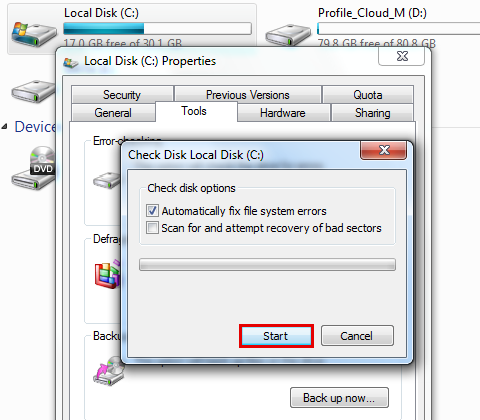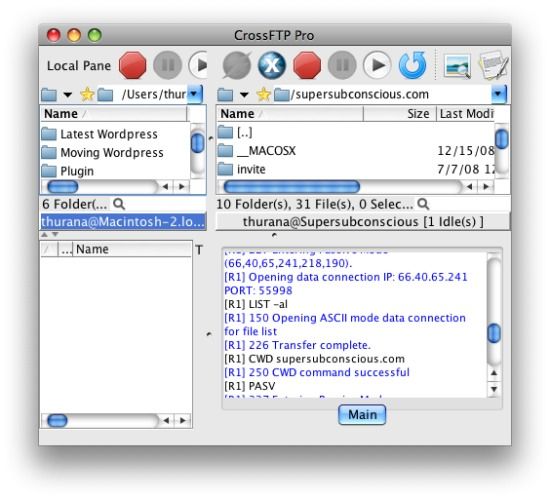There are not many things I miss from Mac OS 9. But there’s one that was really useful: the ability to test a hard drive surface. OS 9 disk formatter (I don’t even recall it’s name) had a “Test Disk” option that would perform a surface scan of the selected hard drive. That was awsome to test for bad blocks on the drives.
Disclaimer: While performing check disk on the hard drive if any bad sectors are found on the hard drive, then chkdsk tries to repair that sector if any data available on that might be lost. Please let us know if the issue got fixed or you need any further assistance. In the second case, bad blocks usually mean that the data contained in those blocks are unfortunately permanently lost. An Uptick in the Number of Bad Sectors. An increase in the number of bad sectors can be a sign of future failure. If the bad sectors are a result of software issues, however. You can try to fix it in Windows or the Mac OS X. This all-in-one software can defrag the Mac’s hard drive once it starts slowing down.
Unfortunately, that’s impossible to do with Mac OS X, at least with it’s built-in software. There are some commerical applications to do that (like TechTool Pro), but I get a little pissed off when I have to spend a lot of money buying a software that does a zillion things when all I want is surface scans, and specially when I could do it with the “old” OS and not with the new powerful UNIX-based one.
Well, Linux has the badblocks command that will do just that: test the disk surface for bad blocks. It’s a simple UNIX command, so I thought there must be a port of that to OS X (and, of course, I could try to compile it in OS X as last resource). After some googling, I found out badblocks is part of the ext2fs tools. And, fortunately, Brian Bergstrand has already done the port to OS X, including a nice installer.

The installer installs all the ext2fs stuff, including an extension that will allow you to access ext2fs volumes on OS X. As always, this is a somewhat risky operation. Personally, I avoid as many extensions as I can, because they run too close to the kernel for me to feel confortable. So, if possible, install it on a secondary OS (like an utility/recover system on an exteral hard drive, or so).
The badblocks command will be installed in /usr/local/sbin/badblocks, and it will probably not be on your PATH, so you have to type the entire path when using, or edit your PATH environment variable.
Usage is simple. First, run the “mount” command, so that you know the device names for the drives you want to test. You can obtain something like this:
arroz% mount
/dev/disk0s3 on / (local, journaled)
devfs on /dev (local)
fdesc on /dev (union)
on /.vol
automount -nsl [142] on /Network (automounted)
automount -fstab [168] on /automount/Servers (automounted)
automount -static [168] on /automount/static (automounted)
The internal hard drive is /dev/disk0 (note that /dev/disk0 is the entire drive, /dev/disk0s3 is a single partition). Imagining you want to test the internal hard drive you would type the command (as root):
badblocks -v /dev/disk0
This would start a read-only test on the entire volume. The -v is the typical verbose setting, so you may follow what’s happening. This will take a long time, depending on the hard drive you use. For a 160 GB hard drive, it took between 2 and 3 hours in a G5 Dual 2 Ghz.
I mention this because time is an important factor when testing hard drives! You should run badblocks on a known-to-be-in-good-condition hard drive, so that you can get the feeling of how fast (or slow) badblocks is. Later, if you test a possibly failing hard drive, and badblocks progresses notably slower, it will probably mean that the hard drive is in bad condition (even if it doesn’t have badblocks).
After running the command, you may get two results: your disk has, or hasn’t badblocks! 🙂 You will see many outputs of a successful surface scan, so I leave here an example of a not-so-successful one:
/usr/local/sbin arroz$ sudo ./badblocks -v /dev/disk0
Password:
Checking blocks 0 to 156290904
Checking for bad blocks (read-only test): 120761344/156290904
120762872/156290904
120762874/156290904
done
Pass completed, 3 bad blocks found.
Auto tune 8 mac torrent. This is the result of a test on a 160 GB hard drive with 3 bad blocks.
After getting something like this, you may try to run badblocks again, in write mode. Note that this will destroy all the information you have on the hard drive! badblocks won’t copy the information to memory, and than back to disk. It simple destroys it. The point of running a write-enabled badblocks check is forcing the hard drive to remap the damaged sectors. Hard drives have a reserved space to use when bad blocks are found. The bad blocks are remapped to that reserved space, until it fills. And this will only happen on a write. So, run badblocks in write mode, and then again in read-only mode. If badblocks finds no bad blocks, your hard drive is fine (for now). If badblocks still finds bad blocks, it means that there are so many damaged blocks on the disk surface that the reserved area is full. Forget it, and throw the disk away. It’s useless.Apple is held in high regard for a number of things: branding, design, innovation and security. All these apply to their entire line of products. What cannot be denied, however, is that there is no device that runs flawlessly.
Even Apple’s high-end computers—the desktop workstation Mac Pro and the laptop MacBook Pro—can still run into problems that plague every hard drive-based computer. This article aims to help in the repair of one specific problem: bad sectors.
Welcome to the homepage of FileZilla®, the free FTP solution. The FileZilla Client not only supports FTP, but also FTP over TLS (FTPS) and SFTP. It is open source software distributed free of charge under the terms of the GNU General Public License. Download FileZilla Client 3.50.0 for Mac OS X. The latest stable version of FileZilla Client is 3.50.0. Please select the file appropriate for your platform below. 
What are bad sectors?
These are parts of the hard drive that cannot be read or written on for new data. The data stored in those sectors either vanished or got corrupted.
Bad sectors also contribute to major slowdown of the computer even in simple processes. They can spread if they are still used, eventually destroying the entire hard disk.
What are the causes of this problem?
Hard drives are fragile pieces of equipment. It cannot take much impact or stand in high temperatures without getting damaged. When the disk inside the drive touches the head due to shock, it can lead to problems. Power outages that occur during data writing can also be a cause. Bad sectors caused by physical damage are called hard bad sectors, and they cannot be repaired.
Another cause of bad sector is the parity bits that got corrupted by malware, resulting in the data not matching when the hard drive is trying to read them. This is called a soft bad sector and fortunately, it can be repaired.
What can be done?
Mac users can rest easy with the help of these five professional programs that can repair soft bad sectors, and help make their Macs run smoother than before.
1. Disk Tools Pro
This all-in-one software can defrag the Mac’s hard drive once it starts slowing down due to excessive use. It alerts the user if a drive is in imminent danger of failing, and it creates a backup of entire volumes for worst case scenarios. They also repair bad sectors, among many other things.
What makes this software convenient is its ability to schedule any of the abovementioned activities without having to boot the damaged volumes with a CD.
Price – $79.99
Developer – Macware
2. SpeedTools Utilities Pro
Detecting bad sectors and repairing them is easy with this compact and affordable software program. It can analyse how much of the hard disk is being used, which files are taking too much space, how much stress the Mac can take, and much more.
The easy-to-navigate interface has everything Mac users need to fix their hard drives. Users can also run multiple processes in different volumes to maximize the time used in Mac repair.
Price – $29.95
Mac Check Disk Space
Developer – Intech Software Corporation
3. TechTool Pro 6
Recover files that have been lost due to corruption or unintentional deletion, create an emergency partition without using a physical DVD, and repair bad sectors even in solid-state drives.
The TechTool Protection feature gives users access to processes that the Mac runs on its own, giving them control on which data to backup in case of drive failure, how much space there is left in the drive, and which files have been deleted.
Price – $99.99
Developer – Micromat
Best free video converter for mac. Any Video Converter Free Mac is the best free video converter to convert any video to MP4, AVI, WMV, MP3, and download YouTube videos, edit video on macOS for free.
4. AlsoftDiskWarrior
Alsoft boasts of unparalleled data recovery with their patent-pending technology in DiskWarrior. Instead of rewriting recovered data on an old directory in a step-by-step process, an entirely new and flawless directory is created with all the lost files.
It can also automatically scan for any hardware issues to keep users up to date with the condition of their hard drives. If an issue is found, it will notify users so that they can back up their files before it is too late.
Price – $99.95
Developer – Alsoft
5. Drive Genius 3

Trusted by Apple’s very own tech support, “Genius Bar”, Drive Genius promises accessible and powerful drive utility tasks to fix and optimize Macs. This latest version is a 64-bit app, making it faster in all of its processes such as defragmentation, sector editing and data shredding.
The new DrivePulse feature checks the physical and digital status of the hard drives, while the Enhanced Repartition can resize partitions without having to delete them. Its Scan feature can detect bad sectors, let the hard drive “know” where that bad sector is, and move data onto a different sector.
Price – $99
Mac Os X Check Disk For Bad Blocks
Developer – Prosoft Engineering
Running into bad sectors on a Mac can be a frustrating experience especially when considering the stability of such computers, but it does not mean the end of their usefulness. Purchasing any of the aforementioned software can solve that seemingly irreparable problem, and they can even find a way to make the Macs faster and more secure.
Mac Os Disk Download
Of course, it would be less expensive to simply keep the Mac from getting these problems in the first place. Here are a few tips:
- Place your computer in a sheltered place to keep it from getting hit or bumped.
- Ensure proper ventilation in the room to keep the hard disk from heating up.
- Make sure that enough voltage is provided to the Mac, especially when a lot of devices are connected to the power supply.
- Get a UPS (uninterruptable power supply), as it helps keep power surges and outages from damaging hard disks.
- Defrag the Mac at least every three months to keep data streamlined, so it wouldn’t have to work so hard locating files.

Author Bio: Jay Manangan is a part time writer and marketing consultant for Repair Labs. An industry-recognized specialist in Laptops, HD camcorder, Gaming Consoles, LG, Samsung, HTC, Nokia, iPhone and iPad accessories as well as iPad and Iphone Repair.
